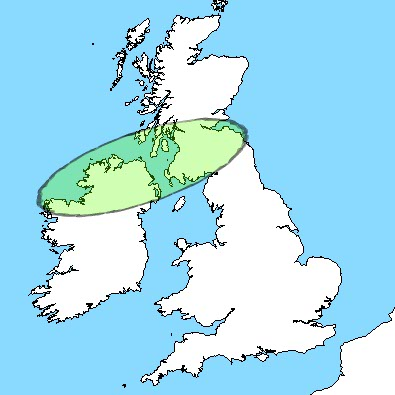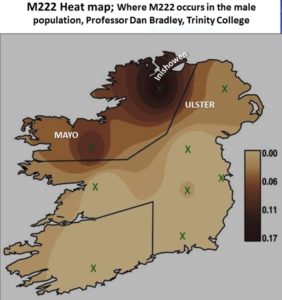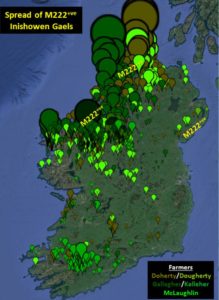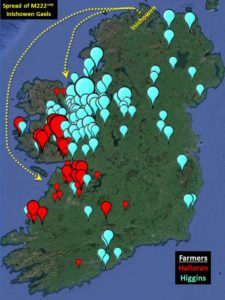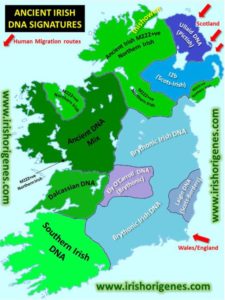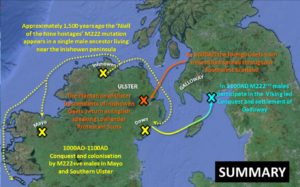Genetic genealogy is the use of DNA testing in combination with traditional genealogical and historical records. Genetic genealogy involves the use of genealogical DNA testing together with documentary evidence to infer the relationship between individuals.
There are three types of tests used; Y chromosome DNA (Y-DNA) tests, Mitochondrial DNA (mtDNA) tests, and Autosomal DNA tests.
Y-DNA tests have been very useful in our McKee family as described in this page and the two subsequent pages. Recently Autosomal DNA testing has become widespread and some McKee results are tabulated in a sub-page Autosomal DNA Tests.
Section A: Y DNA Test Results — Family Matching
Story 1: Link from Charles McKee (1764) to Alexander McKee (1802)
In 2013 Thomas McKee, a second cousin of Debra Van Wagoner Sutherland, had his Y Chromosome STR markers tested by FamilyTreeDNA at their most sensitive level of 111 markers. He was hoping to find matches in their database of about 150 McKee’s which would give his family of Charles McKee (born Ireland, 1764) a glimpse into their Irish roots. That DNA test showed no close matches, but Deb contacted a more distant match, Connel Cannon, and he suggested a few websites where McKee and Lockhart families appeared together. Deb noticed our website of Alexander’s family, born 1802 in Loughros Point, with the remarkable fact of five first names in common with her family of Charles.
Could these common names be coincidence? Deb and I (Barry) both thought not, and guessed that her Charles (b 1764) was an Uncle of my Alexander (b 1802, Loughros Point). When I heard that Deb’s family already had their DNA results available, it was easy for me to say “Me too!” I was tested (111 markers) in December and my results are now available.
Our DNA results are exciting, because we see that Thomas and I have a close match with a difference of 3 STR (short tandem repeat) markers in 111 – a genetic distance of 3, it is called. But we note that DNA testing is somewhat fuzzy, because the STR changes through the generations are random. Referring to the Table provided in the Family Tree DNA website, and copied below as Table 1, we see that our 108/111 match indicates a 50% likelihood of 6 generations to a common ancestor. But we also should note that because the variation between generations is random, the number of generations to a common ancestor has range of values – in this case, 99% confidence in 14 generations.
Table 1: Interpretation of Genetic Distance for 111 STR Markers
| Genetic Distance | Relationship | Interpretation | Related in This Number of Generations or LESS | |||
| Confidence | ||||||
| 50% | 90% | 95% | 99% | |||
| 0 | Very Tightly Related | A 111/111 match indicates an immediate relationship. Most exact matches are 3rd cousins or closer, and over half are related as 1st cousins. | 2 | 4 | 5 | 6 |
| 1 | Tightly Related | A 110/111 match indicates a very close relationship. Over half are 2nd cousins or closer. | 3 | 6 | 7 | 9 |
| 2 | Tightly Related | A 109/111 match indicates a close relationship. Over half are 4th or more recent cousins. | 5 | 8 | 9 | 11 |
| 3 | Related | A 108/111 match indicates a genealogical relationship. Over half will be 5th or more recent cousins. | 6 | 1 0 | 1 1 | 14 |
| 4 | Related | A 107/111 match indicates a genealogical relationship. Over half will be 6th or more recent cousins. | 7 | 11 | 13 | 16 |
If we assume that our closest ancestor is Charles’s (b 1764) father, an Uncle of my Alexander (b 1802), then Thomas has 8 generations to our common ancestor, and I have 5 generations, (see Table below) with a mean value of 6.5 generations, in excellent agree with our DNA result!
Table 2: Calculation for Our Closest Common Ancestor
| For Deb, this would be: | For Barry, if Deb’s Charles is an Uncle of Alexander, then: |
| Generation | Name | DOB | Generation | Name | DOB |
| 0. (common) | Charles’ father | 0. (common) | Charles’s father | ||
| 1. | Charles | 1764 | 1. | Charles’s brother | |
| 2. | Alexander | 1792 | 2. | Alexander | 1802 |
| 3. | Robert | 1820 | 3. | Andrew | 1858 |
| 4. | Wilson | 1841 | 4. | William | 1898 |
| 5. | Shannon | 1869 | 5. | Barry | 1940 |
| 6. | Sterlie | 1896 | |||
| 7. | Leola | 1934 | |||
| 8. | Debra | 1956 |
We can say this DNA result fully supports our belief that Charles and Alexander were close family members.
Story 2: Link from Loughros Point McKees to Malin More McKees
In the past year Deb has noticed many close relationships between “our” Loughros Point McKee family and the McKee family of Malin More townland – McKees in Malin More.
Does DNA testing offer an opportunity to confirm (or deny) this association? Yes, indeed, as Craig’s gr-gr grandfather Andrew (1802) married Fannie Love from Malin More. Table 3 lists Craig’s family from himself to Andrew and Fannie.
Table 3: Family Members from Andrew McKee (and Fannie Love) to Craig McKee
| Andrew McKee b 1802, Donegal d 1867, Coshocton, Ohio |
Fannie Love b 1802, Malin More, Donegal d 1842, Coshocton, Ohio |
| William Charles McKee b 1859, Coshocton, Ohio d 1933, Poweshiek, Iowa |
|
| William E. McKee b 1883, Poweshiek, Iowa d 1948, Poweshiek, Iowa |
|
| Howard G. McKee b 1918, Poweshiek, Iowa d 2010, Poweshiek, Iowa |
|
| Craig William McKee b 1950, Poweshiek, Iowa |
Craig has just done Y-DNA testing and we see a close match to both Deb’s cousin Tom (genetic distance 3) and to me, Barry (genetic distance 4). Referring to Table 1, we see a genetic distance of 3 corresponds to a 50% likelihood of common family member within 6 generations, and a 99% likelihood of a common family member within 14 generations.
These new DNA results tell us that the Loughros Point and Malinmore McKee families were once together, and separated in the range 6 – 14 generations ago.
Section B: Y DNA Test Results – Haplogroup and Subgroup
Our male ancestors (as determined by archeological and linguistic studies along with new DNA testing) arose in Africa about 80,000 years ago, and spread throughout the world in various groups. These groups can now be determined by assignment of their modern Y chromosome DNA results into what are called Haplogroups. More exciting stuff! So now Tom and I (and our families) know we are Haplogroup R1b – subgroup M222, and we can learn about our remarkable history. We have two new sub-pages – European DNA Haplogoups and Haplogroup R1b telling this story. This information is borrowed from Maciamo Hay, at Eupedia.com/genetics
The R-M222 branch of the Y-DNA tree is defined by a single nucleotide polymorphism (SNP) called M222. This diagnostic marker is associated with many individuals whose roots lie in the counties of Northwest Ireland, Ulster and Lowland Scotland.The shaded footprint in the map at left shows the area where this profile is most often found. In no county is this pattern the dominant DNA profile, but in some counties (Donegal in NW Ireland, for example) it approaches 20 percent.
The map is intended only to show a population concentration; R-M222 individuals have roots within the oval but are not constrained by it. R-M222 individuals have been found in nearby areas outside the footprint — in the Western Isles and in Orkney, for example, as well as in the North of England adjacent to the Scottish Border. A very few individuals have been found in Iceland, Norway and Germany.
The cluster now known as the R-M222 group was first recognized in late 2004 following manual cluster analysis of several hundred R-M269 haplotypes in Ysearch. A preliminary modal haplotype was established at that time based on roughly six dozen similar haplotypes. It was noted that family names associated with the cluster were almost entirely Irish or Scot. The cluster was initially referred to as the 25/11/14 cluster based on the dominant values for DYS390, 391 and 392. In late 2005 a research team from Trinity College Dublin published a report that identified this cluster based on the distinctive values at DYS390 and 392. The research team called this pattern the Irish Modal Haplotype, or IMH. Since the haplotype is not in fact modal in Ireland – though a distinctive haplotype, it is a minor one – one should perhaps more properly call this pattern the Northwest Irish/Lowland Scots Variety of R1b1c. That recognizes the fact that it is most concentrated in Donegal (nearly 20 percent of the population) and nearby counties to the south and west (five to 10 percent). It is also found in Lowland Scotland and the Western Isles at a percentage that is hard to determine but may also be in the five to 10 percent range.
In April, 2017 Michael Higgins of www.irishorigenes.com has provided an update on the origin and spread of the M222 genetic marker. It is copied below in Section C.
Section C: MICHAEL D. HIGGINS – The Spread of M222
‘Vikings,’ ‘Foreign Helpers’ and ‘Raiders from across the Sea’
See http://www.irishorigenes.com/content/spread-m222
Approximately 8% of Irish males, together with many Scots and Ulster Scots carry the M222 genetic marker. In fact, two of the most notable males for whom I’ve done work; the President of Ireland Michael D. Higgins and Mr. Norman P. McClelland are both M222+ve. BUT their ancestors took very different paths, President Higgins paternal Catholic Gaelic Irish ancestors originate in Southwest Ireland, while Mr. McClelland’s ancestors were Ulster Protestant Scots! The paths that their ancestors took are only now being uncovered with the help of modern commercial ancestral DNA testing and they serve to highlight the changes in identity which our ancestors went through, some gradual, some quite rapid.
The M222 Y-DNA genetic marker first appeared in a single male who lived on, or near, the Inishowen peninsula in the far northwest of Ireland approximately 1,500 years ago (Fig 1). If you are M222+ve then your paternal ancestry will involve lots of Dohertys! The Dohertys are ubiquitous among the majority of M222+ve test subjects. That’s no coincidence, Doherty is the most common surname in Inishowen and they were the most prominent Clan in Inishowen; their castles and towerhouses dominate that area! However, scientific research and Y-DNA Case Studies performed at Irish Origenes have revealed areas beyond Inishowen shores where M222+ve males predominate in the local population, particularly along Irelands west coast (Moy River valley), Southeast Ulster (between Carlingford and Strangford Loughs) and Southwest Scotland (Galloway). This spread throughout Ireland is confirmed by an examination of the distribution of M222+ve surnames like Doherty, McLaughlin and Gallagher which can be found along Irelands west coast and to a lesser extent within County Down in Southeast Ulster (fig 2). What is particularly notable is that the M222+ve males who spread beyond Inishowen, particularly along the west coast of Ireland have acquired new surnames like Higgins and Halloran (fig 3).
Clues as to why these M222+ve Gaels began colonising throughout Ireland (and beyond) can be found in their origin; Donegal (Dún na nGall meaning ‘base or fort of the Foreigner’) and their descriptive surnames which they took with them like Gallagher (Ó Gallchobhair meaning ‘Foreign helper’) who upon settling along the west coast of Ireland acquired new surnames like Higgins (O’hUigin meaning ‘Viking’) and Halloran (O’hAllmhurain meaning ‘Pirate or Stranger from overseas’). Modern DNA science indicates that just after the appearance of surnames (1000AD) the M222+ve Gaels of Inishowen had formed an alliance with Scandinavian ‘Vikings’ and that Christian-Gael and Heathen-Gall (Gall = foreigners) had together raided and colonised throughout Ireland, an embarrassing alliance which has disappeared from Irish historical records. In support of this Viking-Inishowen connection, research at Irish Origenes has uncovered at least two individuals with recent Inishowen ancestry but with Scandinavian Y-DNA signatures, clear evidence of Scandinavian contact with Inishowen (Fig 4).
Some of the M222+ve males who settled in Southeast Ulster took part in the subsequent Norse-Gael Conquest and colonisation of Southwest Scotland which was led by the King of Norway ‘Magnus Barelegs’ in about 1100AD. The land they conquered became ‘Galloway’ meaning ‘land of the foreign Gael’ a term used by the surrounding ‘Scots’ to describe the Gaels from Ireland who settled there. The Inishowen Gaels took with them to Galloway their genetic markers (like M222), their Gaelic language, and their surnames like McLaughlin, McGowan, McKean, Kelly and McGee (Gaelic surnames dominate Galloway; see the accompanying surnames of Galloway image, Fig 5). However, in the areas where M222+ve Gaels settled permanently they acquired new surnames like MacClellan, MacCartney and MacKnight. The Scots are a diverse bunch and many Scottish surnames reveal the origin of the bearer; Galloway reveals the surname ‘Ireland” (red arrow – Fig 5). What’s particularly interesting is that Conquering Gaels and Vikings appear to have split Southwest Scotland between them, with the Gaelic-Irish (denoted by their ‘Mac’ surnames) colonising the area west of Dumfries town, while the Vikings (with surnames typically ending in ‘-son’) colonising the area to the east.
If one examines the Medieval Clan territories of Galloway the division between M222+ve Irish Clans (red arrows, Clans of Galloway, Fig 6) and Viking Families is quite striking (Fig 6). Magnus was the last truly ‘Viking’ King of Norway and he was murdered by his Irish Allies in County Down in Southeast Ulster, it would appear that King Magnus had outgrown his usefulness among the Gaelic Irish and Viking settlers who divided his conquered territory (including Galloway) between themselves.
In Galloway in Southwest Scotland, the Irish Gaels gradually adopted the English language (Gaelic was extinct as a language in Galloway by 1760AD), they later adopted the Protestant faith, and approximately 500 years after their ancestors had first arrived in Galloway, many would return as English speaking Protestant Lowland Scots during the Plantation of Ulster that began in the early 17th Century. Within Ireland they would have settled among their distant Gaelic Irish relatives, some may have been aware of their earlier Irish connection (the McClelland family has always had a strong sense of its Irish identity). Today, a high proportion (up to 30%) of Protestant males in Northern Ireland, and males in the US with Ulster Scots roots carry the M222 genetic marker. See Summary, Fig 7.

